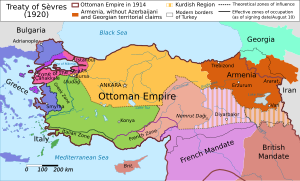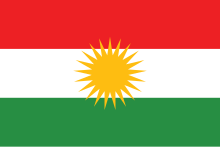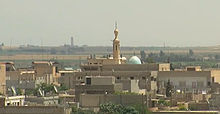Qamishli is a city in northeastern Syria on the Syria–Turkey border, adjoining the city of Nusaybin in Turkey. The Jaghjagh River flows through the city. With a 2004 census population of 184,231, it is the ninth most-populous city in Syria and the second-largest in Al-Hasakah Governorate after Al-Hasakah. Qamishli has traditionally been a Christian Assyrian majority city, but is now predominantly populated by Kurds with large numbers of Arabs and Assyrians and a smaller number of Armenians. It is 680 kilometres (420 mi) northeast of Damascus.

Al-Hasakah Governorate is one of the fourteen governorates (provinces) of Syria. It is located in the far north-east corner of Syria and distinguished by its fertile lands, plentiful water, natural environment, and more than one hundred archaeological sites. It was formerly known as Al-Jazira Province. Prior to the Syrian Civil War nearly half of Syria's oil was extracted from the region. It is the lower part of Upper Mesopotamia.

Upper Mesopotamia constitutes the uplands and great outwash plain of northwestern Iraq, northeastern Syria and southeastern Turkey, in the northern Middle East. Since the early Muslim conquests of the mid-7th century, the region has been known by the traditional Arabic name of al-Jazira and the Syriac variant Gāzartā or Gozarto (ܓܙܪܬܐ). The Euphrates and Tigris rivers transform Mesopotamia into almost an island, as they are joined together at the Shatt al-Arab in the Basra Governorate of Iraq, and their sources in eastern Turkey are in close proximity.
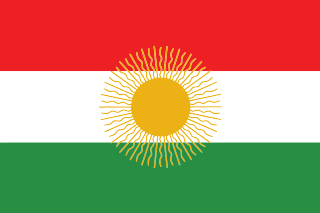
Xoybûn or Khoyboun was a Kurdish nationalist political party, that is known for leading the Ararat rebellion, commanded by Ihsan Nuri. Many Armenians joined the movement as well, the party was active in all parts of Kurdistan until it was dissolved in 1946.
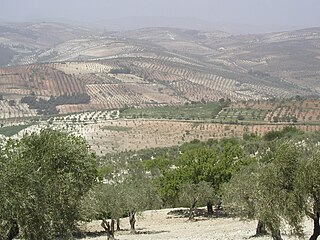
Kurd Mountain or Kurd Dagh is a highland region in northwestern Syria and southeastern Turkey. It is located in the Aleppo Governorate of Syria and Kilis Province of Turkey. The Kurd Mountain should not be confused with the neighboring Jabal al Akrad, which is located further southwest in Latakia Governorate.
Amuda is a town in Al Hasakah Governorate in northeastern Syria close to the Syria–Turkey border. As a result of the ongoing civil war, Amuda is currently under the civil control of the AANES and military control of the SDF and Syrian Army.

Afrin District is a district of Aleppo Governorate in northern Syria. The administrative centre is the city of Afrin. At the 2004 census, the district had a population of 172,095. Syria's Afrin District fell under the control of the People's Protection Units (YPG) around 2012 and an "Afrin Canton" was declared in 2014, followed by an "Afrin Region" in 2017. During Operation Olive Branch, the entire district was captured by Turkey and its allies.
The 2004 Qamishli riots were an uprising by Syrian Kurds in the northeastern city of Qamishli in March 2004, which culminated in a massacre by the Syrian Arab Armed Forces.
Mashaal Tammo, also Mash'al Tammo was a Syrian politician and activist who supported the interests of the minority of the Kurds.

The Kurdistan Democratic Party of Syria, commonly known as KDPS or PDK-S, is a Kurdish Syrian political party founded in 1957 by Kurdish nationalists in northern Syria. The party is based in Hamburg, Germany and has various branches in France, United Kingdom, Sweden and the United States of America.
Al-Jazira Province was an administrative division in the State of Aleppo (1920–25), the State of Syria (1925–1930) and the first decades of the Mandatory Syrian Republic, during the French Mandate of Syria and the Lebanon. It encompassed more or less the present-day Al-Hasakah Governorate and part of the former Ottoman Zor Sanjak, created in 1857.

The Autonomous Administration of North and East Syria (AANES), also known as Rojava, is a de facto autonomous region in northeastern Syria. It consists of self-governing sub-regions in the areas of Afrin, Jazira, Euphrates, Raqqa, Tabqa, Manbij, and Deir Ez-Zor. The region gained its de facto autonomy in 2012 in the context of the ongoing Rojava conflict and the wider Syrian civil war, in which its official military force, the Syrian Democratic Forces (SDF), has taken part.

The Jazira Region, formerly Jazira Canton,, is the largest of the three original regions of the de facto Autonomous Administration of North and East Syria (AANES). As part of the ongoing Rojava conflict, its democratic autonomy was officially declared on 21 January 2014. The region is in the Al-Hasakah Governorate of Syria.

Afrin Region is the westernmost of the three original regions of the Autonomous Administration of North and East Syria.

Syrian Kurdistan is a region in northern Syria where Kurds form the majority. It is surrounding three noncontiguous enclaves along the Turkish and Iraqi borders: Afrin in the northwest, Kobani in the north, and Jazira in the northeast. Syrian Kurdistan is often called Western Kurdistan or Rojava, one of the four "Lesser Kurdistans" that comprise "Greater Kurdistan", alongside Iranian Kurdistan, Turkish Kurdistan, and Iraqi Kurdistan.

The Rojava conflict, also known as the Rojava Revolution, is a political upheaval and military conflict taking place in northern Syria, known among Kurds as Western Kurdistan or Rojava.

The Kurdish Democratic Progressive Party in Syria is one of the oldest Kurdish parties in Syria, having been active since seceding from the Kurdistan Democratic Party of Syria the 1960s. Prominently led by Abd al-Hamid Darwish for much of its history, who was described as "one of the last remaining of the original Kurdish political activists", the PDPKS serves as the Syrian sister party of the Iraqi Patriotic Union of Kurdistan. Known for its moderate and conciliatory politics, the party has sided at different times during the Syrian Civil War with the Syrian opposition, the Ba'athist government, the Kurdish National Council, and the Democratic Union Party.

The Arab Belt was the Syrian Ba'athist government's project of Arabization of the north of the Al-Hasakah Governorate to change its ethnic composition of the population in favor of Arabs to the detriment of other ethnic groups, particularly Kurds.

Afrin Canton was one of the cantons of Rojava. Syria's Afrin District fell under the control of the People's Protection Units (YPG) around 2012 and an "Afrin Canton" was declared in 2014. Afrin Canton in its latest form was established in 2017, however, as part of the reorganisation of Rojava's subdivisions. With Afrin as its administrative centre, the canton was part of the larger Afrin Region. As a result of Operation Olive Branch in early 2018, Afrin Canton became part of the Turkish occupation of northern Syria. The government of the Afrin Region now administers only the area around Tell Rifaat.
Kurdish immigration into Syria has occurred since ancient times. Today Kurds form about 10% of Syria's population, numbering around 2 million. The majority of Kurds in Syria immigrated from Turkey to the French Mandate the 20th century to escape persecution. Most of these Kurds live in northeast Syria, with smaller communities scattered in various places across the country.



